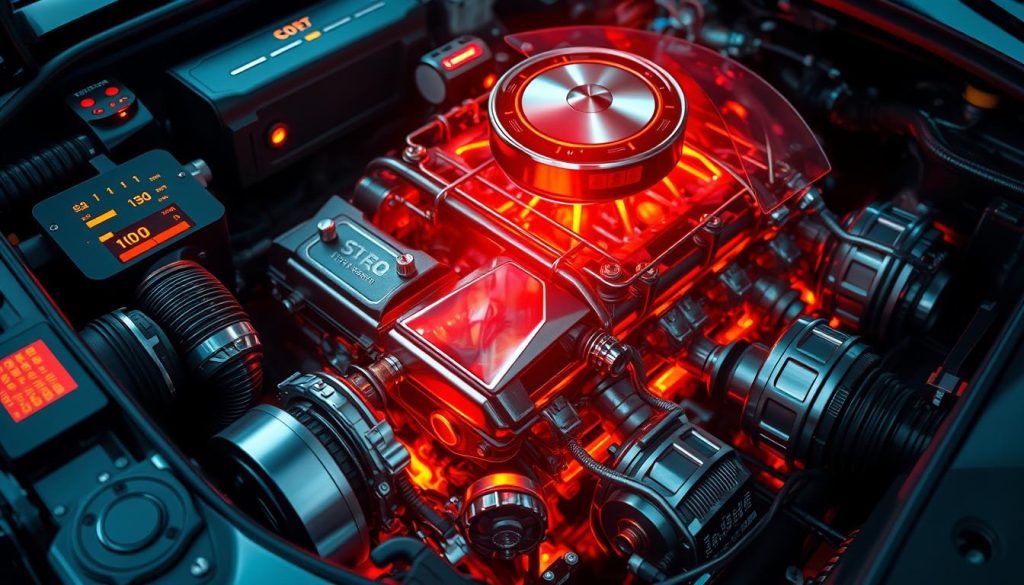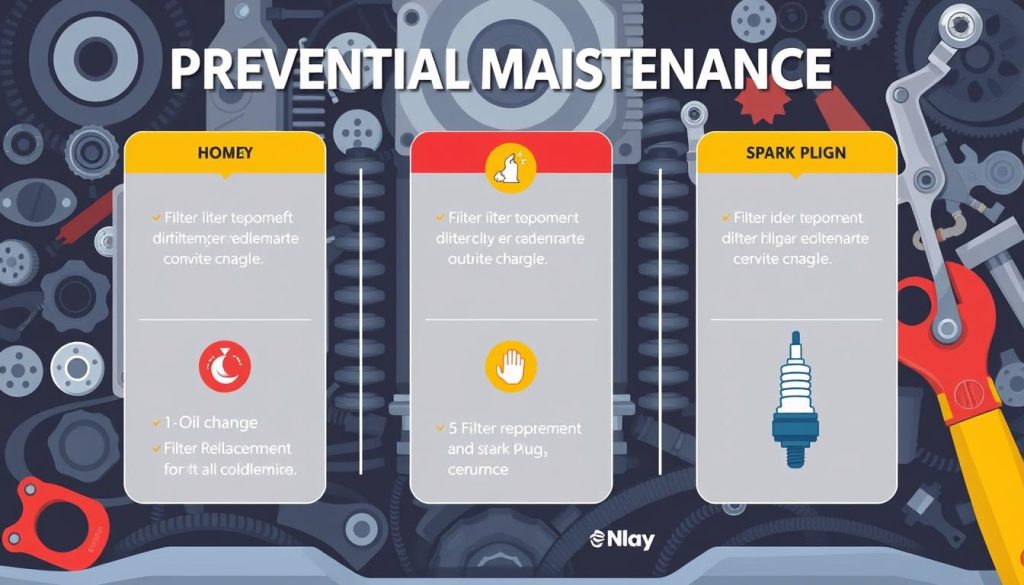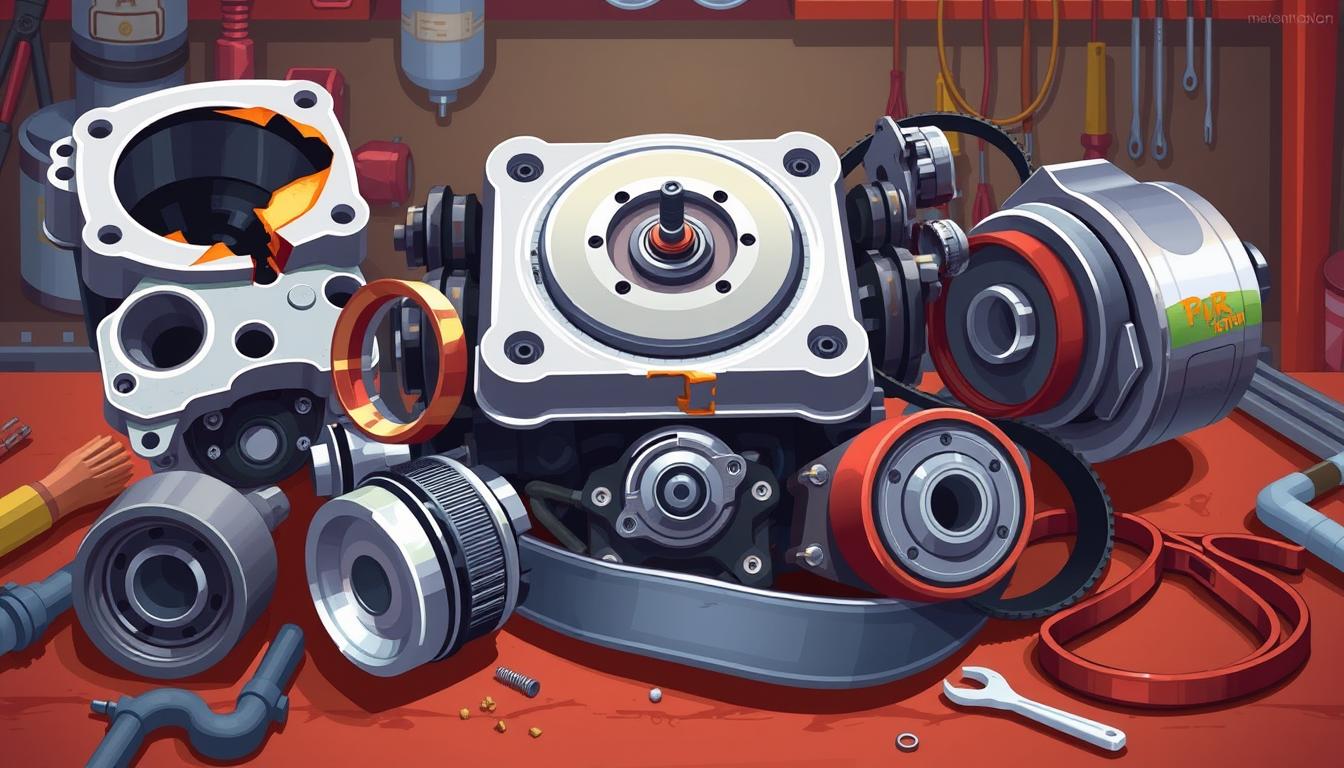Car engines, the core of our vehicles, are not indestructible. It’s vital to grasp common engine issues for effective car upkeep and to dodge expensive repairs. Knowing which parts are more susceptible to damage can prevent unnecessary expenses, save time, and reduce stress.
Exploring engine components reveals why some parts deteriorate faster than others. We’ll examine the influence of driving habits and maintenance practices on engine longevity. We’ll also discuss the critical signs that indicate engine problems are on the horizon.
This guide is for both car aficionados and everyday drivers aiming to maintain their vehicles’ performance. It equips you with the knowledge to identify and address issues before they escalate into major engine failures. By being proactive in your maintenance routine, you can safeguard these vulnerable components and prolong your engine’s life.
Key Takeaways
- Identifying frequently damaged engine parts is essential for preventive maintenance
- Driving habits significantly impact the wear and tear on engine components
- Regular check-ups can catch minor issues before they become major problems
- Understanding common engine problems helps in early detection of potentially catastrophic failures
- Proper maintenance routines can extend the lifespan of critical engine parts
- Recognizing warning signs can prevent unexpected breakdowns and costly repairs
Understanding Car Engine Components and Their Vulnerability
Car engines are marvels of engineering, with intricately designed parts working in concert to power our vehicles. Let’s explore the engine structure and how various factors impact its performance.
Basic Engine Structure Overview
The heart of a car’s engine comprises several critical components. The engine block encases cylinders, pistons, and the crankshaft. Above, the cylinder head contains valves and camshafts. These elements work in unison to transform fuel into motion.
Common Stress Points in Modern Engines
Modern engines face numerous stress points. The combustion chamber endures extreme heat and pressure. Valve trains experience constant motion, leading to wear. Gaskets and seals are susceptible to leaks under high temperatures. Understanding these stress points is essential for maintaining engine health.
Impact of Driving Habits on Engine Wear
Your driving habits significantly influence engine wear. Frequent short trips prevent proper warm-up, causing increased wear. Aggressive acceleration and braking strain engine components. Overloading your vehicle puts extra stress on the engine structure. By adopting smoother driving techniques, you can reduce wear and extend your engine’s lifespan.
| Driving Habit | Impact on Engine |
|---|---|
| Frequent cold starts | Increased wear on cylinders and pistons |
| Aggressive acceleration | Higher stress on connecting rods and bearings |
| Overloading | Excessive strain on engine mounts and crankshaft |
By understanding engine components and their vulnerabilities, you can make informed decisions about vehicle maintenance and driving habits. This approach will help prolong your engine’s life.
Signs of Critical Engine Part Failure
Identifying engine failure symptoms early can prevent expensive repairs. Car owners must be vigilant for warning signs of engine issues. These indicators manifest as performance, sound, or visual changes in your vehicle.
- Smoke from the exhaust
- Oil puddles under your car
- Dashboard warning lights
Unusual sounds can signal engine trouble. Listen for:
- Knocking or ticking noises
- Loud exhaust
- Squealing or grinding
Performance changes often hint at underlying engine problems. Watch out for:
- Decreased fuel efficiency
- Loss of power
- Rough idling or stalling
| Warning Sign | Possible Engine Problem | Recommended Action |
|---|---|---|
| Blue exhaust smoke | Oil leak in combustion chamber | Check oil levels, consult mechanic |
| Knocking sound | Worn bearings or pistons | Immediate professional inspection |
| Check Engine Light | Various issues | Diagnostic scan needed |
| Vibrations while driving | Engine mounts or balance issues | Schedule mechanic visit |
Being aware of these signs can help you address engine issues before they escalate into major problems. Regular maintenance and prompt attention to warning signs are key to keeping your engine healthy and avoiding unexpected breakdowns.
Car Engine Parts Most Prone to Heat Damage
Engine heat damage poses a significant threat to car owners. Overheating can cause severe issues, impacting various components. We will examine the parts most susceptible to thermal stress and the significance of effective engine cooling.
Head Gasket Deterioration
Head gaskets are essential for sealing the combustion chamber. Excessive heat can cause them to warp or crack. This results in coolant leaks, oil contamination, and decreased engine performance. Regular inspections and maintaining proper coolant levels are vital to prevent head gasket failure.
Piston and Ring Problems
Pistons and rings endure intense heat during engine operation. Overheating can cause them to expand beyond their design limits. This leads to scoring of cylinder walls and loss of compression. Ensuring adequate lubrication and cooling is critical to protect these vital components.
Valve Train Issues
The valve train system is highly susceptible to heat damage. High temperatures can warp valves, leading to poor sealing and reduced engine efficiency. Valve guides and seats may also deteriorate, causing oil leaks and increased emissions. Regular oil changes are essential to maintain valve train health.
Cylinder Head Complications
Cylinder heads are prone to warping under extreme heat. This can result in blown head gaskets and coolant leaks. In severe cases, cracks may form, requiring expensive repairs or replacement. Proper engine cooling is critical to prevent such issues.

| Engine Part | Heat Damage Risk | Prevention Method |
|---|---|---|
| Head Gasket | High | Regular coolant checks |
| Pistons and Rings | Medium | Proper lubrication |
| Valve Train | Medium | Timely oil changes |
| Cylinder Head | High | Maintain cooling system |
Most Common Oil-Related Engine Failures
Engine oil is essential for your car’s smooth operation. Failure in the lubrication system can cause significant engine damage. We will examine common oil-related problems that can harm your engine.
Oil Pump Malfunctions
The oil pump is vital for your engine’s lubrication. It ensures the engine oil circulates, maintaining pressure. A malfunction can lead to severe engine damage in minutes. Look out for low oil pressure warnings and unusual engine noises as signs of a faulty oil pump.
Bearing Wear Patterns
Engine bearings need a thin oil film to function. Without it, or with contaminated oil, they wear out quickly. This often manifests as a knocking sound, most noticeable during start-up.
Timing Chain Deterioration
The timing chain requires constant lubrication. Neglecting oil changes can lead to sludge buildup, causing the chain to stretch or break. This can result in catastrophic engine failure if not addressed promptly.
| Oil-Related Issue | Symptoms | Prevention |
|---|---|---|
| Oil Pump Failure | Low oil pressure, engine noise | Regular oil changes, quality oil |
| Bearing Wear | Knocking sounds, poor performance | Timely oil changes, clean oil |
| Timing Chain Issues | Rattling noise, engine misfires | Frequent oil changes, proper oil level |
Regular oil changes and maintaining the right oil pressure are critical. Skipping scheduled maintenance can be far more costly than engine replacement.
Electrical Component Vulnerabilities
Car engines depend on a sophisticated electrical system to operate efficiently. At the heart of this system are the alternator, starter motor, and battery. Each component is essential for maintaining your vehicle’s performance.
The alternator is responsible for generating electricity to power your car’s systems and recharge the battery. It can fail due to worn bearings, faulty diodes, or a broken belt. Such malfunctions can cause your car’s electrical components to dim or fail completely.
Starter motors are vital for starting your engine when you turn the key. They can deteriorate from frequent use or excessive heat. A failing starter motor may produce grinding noises or fail to turn over the engine.
The battery serves as the energy reservoir, providing power to start your car. It is susceptible to extreme temperatures and can be drained by leaving lights on or other electrical components running when the engine is off.
| Component | Common Issues | Warning Signs |
|---|---|---|
| Alternator | Worn bearings, faulty diodes | Dimming lights, dead battery |
| Starter Motor | Worn gear, burnt contacts | Grinding noise, failure to start |
| Battery | Corroded terminals, sulfation | Slow crank, electrical issues |
Regular maintenance of your car’s electrical system can prevent many issues. Keep an eye out for warning signs and address problems promptly to avoid being stranded with a non-starting vehicle.
Impact of Poor Maintenance on Engine Parts
Ignoring your car’s engine maintenance can lead to severe issues. Regular servicing is essential for maintaining your vehicle’s performance. We will examine how neglect impacts engine components and why proactive care is vital.
Preventable Damage Patterns
Forgetting to change the oil results in sludge accumulation, harming critical parts. Neglecting to replace dirty air filters hampers airflow, lowering fuel efficiency. Ignoring unusual sounds or vibrations can cause significant engine failures. These problems are avoidable with diligent maintenance.
Maintenance Schedule Importance
Adhering to your car’s maintenance schedule is critical for engine longevity. Regular inspections identify minor problems before they escalate into expensive repairs. Adhering to recommended service intervals ensures your engine remains in optimal condition.

Cost Implications of Neglect
Disregarding preventive maintenance increases repair costs over time. Here’s a comparison of the expenses of routine servicing versus major engine overhauls:
| Maintenance Item | Average Cost | Potential Repair if Neglected | Repair Cost |
|---|---|---|---|
| Oil Change | $50-$100 | Engine Replacement | $4,000-$7,000 |
| Air Filter Replacement | $20-$50 | Fuel System Cleaning | $200-$500 |
| Timing Belt Replacement | $500-$900 | Engine Rebuild | $2,500-$4,500 |
Investing in preventive maintenance not only saves money but also extends your engine’s lifespan. Proactive measures are necessary to safeguard your vehicle’s engine.
Environmental Factors Affecting Engine Durability
Engine durability is heavily influenced by environmental factors. The climate significantly impacts the longevity of your vehicle’s engine. Extreme temperatures, whether hot or cold, exert additional stress on engine components.
In intense heat, engine oils become thinner, losing their protective properties. On the other hand, cold weather causes oil to thicken, hindering engine start-up. These temperature fluctuations accelerate wear and tear on critical parts.
Air quality also plays a significant role. High pollution levels can clog air filters more quickly, forcing engines to work under increased strain. This strain can significantly shorten the lifespan of essential components.
Corrosion poses a silent threat to engines, more so in coastal or humid environments. Salt air and moisture can corrode metal parts, weakening them over time. Implementing regular washing and undercoating can help mitigate this risk.
| Environmental Factor | Impact on Engine | Prevention Tip |
|---|---|---|
| Extreme Heat | Oil thinning, faster wear | Use high-grade oil, park in shade |
| Extreme Cold | Hard starts, thickened oil | Use engine block heater |
| Poor Air Quality | Clogged filters, increased wear | Change air filters more often |
| High Humidity | Corrosion of metal parts | Regular washing, undercoating |
Recognizing these environmental impacts enables proactive measures to safeguard your engine. Tailoring regular maintenance to your local climate can substantially prolong your engine’s lifespan.
Modern Technology and Engine Part Protection
Car engines have evolved significantly with the advent of advanced technology. Today’s vehicles boast sophisticated systems designed to protect engine components and boost performance. These innovations are transforming the way we care for engines.
Advanced Monitoring Systems
Modern cars are equipped with complex engine diagnostics systems that continuously monitor engine health. These onboard computers gather data from numerous smart sensors across the engine. They track vital metrics such as oil pressure and exhaust emissions, providing real-time insights into the engine’s condition.
Protective Features in New Engines
Manufacturers are integrating innovative protective features into new engines. These include:
- Thermal management systems to prevent overheating
- Variable valve timing for improved efficiency
- Start-stop technology to reduce wear during idle
These features collectively aim to extend engine lifespan and ensure optimal performance.
Smart Maintenance Solutions
Predictive maintenance is revolutionizing engine care. By analyzing data from onboard computers, mechanics can forecast issues before they arise. This proactive strategy helps avert major breakdowns and cuts down repair expenses. Some vehicles even alert drivers when maintenance is due, ensuring timely care for critical engine parts.
As technology progresses, we can anticipate even more advanced solutions for engine protection. From AI-driven diagnostics to self-healing materials, the future of engine care is promising for both car owners and mechanics.
Conclusion
Grasping the intricacies of your car’s engine is fundamental to its longevity. Recognizing which components are prone to deterioration allows for proactive maintenance. Engine care transcends mere repairs; it’s about preemptive measures to avert future issues.
Consistent inspections and prompt repairs are indispensable for preventive maintenance. These actions not only mitigate financial burdens but also alleviate future inconveniences. A well-kept engine is the cornerstone of a vehicle’s enduring performance. It’s a commitment to your car’s continued serviceability, extending its life far beyond the present.
Being an astute car owner entails vigilance towards early warning signs and adherence to maintenance protocols. Such awareness equips you with the capability to make informed decisions regarding your vehicle’s health. Through diligent engine care, you safeguard not only your investment but also the safety and dependability of your journeys.

Leave a Reply